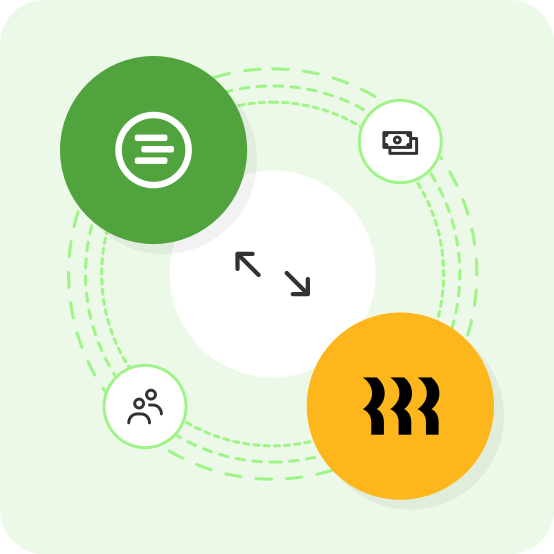Ultimate Restaurant Payroll Management Guide
Try When I Work for free
Managing restaurant payroll can quickly become a headache. Between calculating tips, handling fluctuating hours, and avoiding costly mistakes, it’s easy to feel overwhelmed. Payroll errors not only eat into precious time but also risk financial penalties.
Let’s simplify restaurant payroll management so you can worry about running your business rather than managing payroll.
Key takeaways
Here are the important things to know about restaurant payroll management:
- Tracking employee hours helps prevent payroll errors
- Avoid penalties by staying on top of labor laws and tax regulations
- Payroll automation reduces manual work
- Tip management ensures fair compensation and compliance
- Payroll management is made easy with automated software
Table of contents
- What is restaurant payroll management?
- Common restaurant payroll management challenges
- How to improve your food service payroll management
- Business benefits of having an efficient payroll process for your restaurant
- How to automate your restaurant payroll management
What is restaurant payroll management?
Restaurant payroll management is calculating and distributing employee wages while ensuring compliance with tax laws and labor regulations. It also involves managing tips, tracking hours, and keeping accurate restaurant records.
70% of restaurateurs have automated payroll, recognizing the importance of avoiding fines, ensuring accurate payments, and maintaining smooth operations. Proper payroll management keeps employees satisfied and ensures the restaurant complies with legal requirements.
What is the payroll process for restaurants?
Restaurant payroll management involves several critical steps to ensure accurate and timely payments. Here’s how it typically unfolds in restaurant management:
1. Complete the necessary paperwork
Collect the necessary documents from new hires, like the W-4 form for tax withholding and the I-9 form for work eligibility. Don’t forget to report cash and credit card tips. Payroll processing is easier with this documentation.
2. Set a payroll schedule
Set up an automatic pay schedule that aligns with your restaurant’s operations. Choose weekly, biweekly, or monthly periods based on your cash flow. Consistent pay periods ensure employees get paid on time and help avoid legal problems. Just make sure this schedule fits your restaurant’s needs so you’re efficient and compliant.
3. Calculate payroll taxes
Determine each employee’s gross pay. Calculate your deductions for Social Security and Medicare (FICA) taxes and federal and state income taxes. Payroll tax calculations must be accurate to prevent compliance issues, fines, or penalties.
Who is responsible for payroll management at restaurants?
Restaurant payroll management varies depending on the size and structure of the restaurant. A smaller restaurant usually has an owner or manager handle payroll, while a chain might have a dedicated HR team. Franchisees may manage payroll centrally, with corporate offices ensuring compliance locally.
Common restaurant payroll management challenges
Managing a restaurant can be rewarding, but restaurant payroll management often brings its own set of challenges, which include the following:
Accounting for tips
Handling tips is a significant aspect of restaurant payroll management. Different jurisdictions have different tip guidelines. According to California’s Labor Code Section 351, tips belong to the employees who get them. Regulations allow:
- There’s no tip-pooling for owners, managers, or supervisors
- Requiring employees to share tips with other service staff
FICA allows tips to count towards minimum wage requirements. Restaurant owners must ensure that tips cover the required wage.
Maintaining tax compliance
Why handle payroll taxes manually when tax automation is available? Some restaurant owners still do, and it’s risky. Missteps in withholding and submitting income, Social Security, and Medicare taxes can attract IRS scrutiny.
Payroll software simplifies compliance by automating tax calculations and managing federal, state, and local deductions. It also provides employees with easy access to tax forms like W-2s.
Managing manual spreadsheets and avoiding errors
A manual spreadsheet for payroll management is a risky choice in the restaurant industry because of its unpredictable nature. Managing irregular hours, multiple positions, and shifts can result in costly mistakes, like overpaying or underpaying employees. Payroll automation significantly reduces these risks. Software tools can simplify complicated calculations, streamline tax filings, and minimize human error. Without manual methods, payroll runs smoothly.
Accurately tracking restaurant employee hours
Errors in tracking employee hours often lead to compliance issues, payroll disputes, and incorrect payments. Maintaining accurate records ensures compliance with labor laws, resolves employee disputes quickly, and avoids costly mistakes.
Back-office software offers a solution by automating the tracking of hours, overtime, and breaks, reducing the chance of errors. Regularly reviewing these records allows for quick identification and correction of inconsistencies, helping to keep payroll accurate and reliable.
How to improve your food service payroll management
According to IRS estimates, payroll errors affect about one-third of organizations annually. Restaurant payroll management is particularly complex, with factors like tips, overtime, and multiple job roles.
Here are ways to improve food service payroll management:
Know the regulations and laws relevant to your business
Restaurant payroll management requires staying current with regulations to avoid fines, penalties, and payroll errors. Changes in income tax rates, minimum wage laws, and overtime rules can impact payroll.
Common regulations include:
- The Fair Labor Standards Act (FLSA) enforces minimum wage and overtime laws, which vary by state and apply to all restaurants
- The Occupational Safety and Health Act (OSHA) mandates a safe work environment, though specific regulations can differ by state
- The Family and Medical Leave Act (FMLA) requires companies with 50 or more employees to provide job-protected medical or family leave for qualifying situations
Keep track of your payroll records
Auditing your payroll process is a smart move in restaurant payroll management. Preventing errors starts with accurate payrolls and tax filings. Detailed payroll records will give you insights into payroll costs, absenteeism rates, and tax payments.
The Fair Labor Standards Act (FLSA) says employers must record employees’ names, addresses, occupations, hours worked, and wages for three years. Employers have to keep payroll tax records for four years.
Be sure that your payroll process accounts for tipping
Tips are taxable income, so both employees and employers require proper reporting.
Restaurants must balance tip credits and minimum wage compliance. The IRS expects reported tips to equal at least 8% of total receipts per pay period. Software that handles tip calculations and reporting can simplify this process and reduce errors, ensuring your payroll complies with all regulations.
Integrate time tracking and payroll for better accuracy
Combining time tracking with payroll improves accuracy and reduces errors in restaurant payroll management. An employee scheduling software like When I Work, which includes a time clock feature, automatically records hours worked and syncs them with payroll.
Add a payroll integration to save more time! Learn more about our available integrations and see how you can simplify scheduling and payroll for your team.
Automate your restaurant payroll process
Automation reduces repetitive tasks, freeing up time for critical responsibilities and ensuring accurate tax calculations. It makes the entire process easier and more reliable by efficiently processing payments and triggering direct deposits.
Business benefits of having an efficient payroll process for your restaurant
An efficient payroll process benefits a business in many ways, helping you:
Avoid legal fees and other unexpected expenses
Efficient payroll management helps avoid costly legal fees and unexpected expenses by ensuring compliance with labor laws. Payroll software tracks overtime, calculates shift premiums, and meets minimum wage requirements.
Automation makes calculating holiday pay and split shifts much easier. Accurate records and documentation also reduce stress and potential fines in an audit.
Have better insight into your labor costs
With accurate payroll data, it’s easier to spot trends like increased overtime or reduced time off. Making informed decisions is easier when you know what payroll costs are.
Analyzing sick leave or vacation time patterns can help you adjust staffing levels, reducing unnecessary labor expenses. Payroll analytics also allows you to reallocate resources where needed most, improving overall efficiency and cost management.
Make informed decisions to reduce labor expenses
Payroll automation gives you the data you need to make informed decisions. You can easily analyze employee hours, overtime, and productivity with an integrated system.
Let’s say you notice certain shifts always require overtime. You can control costs by changing staffing levels or redistributing hours. It helps you make better decisions, reduce labor costs, and improve efficiency.
How to automate your restaurant payroll management
You can automate your restaurant payroll, making it faster and more accurate.
Self-service tools let employees manage direct deposits, update personal information, and access pay stubs. Automation makes it easier to keep payroll running smoothly.
When I Work preferred payroll partner
Make payroll simple with our preferred partner Rippling, an all-in-one platform for payroll, benefits, and compliance. Together, When I Work and Rippling help you save hours every week while reducing errors, staying compliant, and getting your team paid on time.

Pay your restaurant employees accurately with help from When I Work
When I Work offers scheduling, time tracking, attendance, and payroll integrations, so it ensures accurate timesheets automatically make it to your favorite payroll provider.
When I Work integrates seamlessly with payroll providers to save you even more time. Our payroll integrations, especially the one to our preferred partner, Rippling, help you connect scheduling and payroll in one streamlined workflow, so you can focus on running your business, instead of reconciling timesheets.
With real-time insights into labor costs and easy-to-use features, When I Work simplifies every aspect of workforce management. Sign up for a free trial of When I Work and see how it can transform your business.






